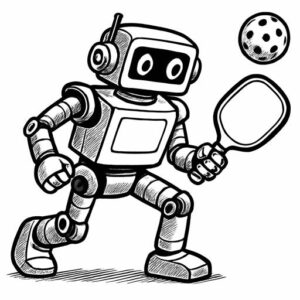The Rise of Pickleball Robots: Can a Machine Beat Your Dink?
Overview
Pickleball robots, in the form of advanced ball machines, are currently used to enhance training by delivering consistent, customizable shots for drilling and skill development. These machines, often referred to as robots due to their programmable and automated features, are not humanoid robots but sophisticated devices that simulate various shots like dinks, volleys, and serves. While speculative discussions about futuristic humanoid robots, such as those being developed by Elon Musk’s Tesla, suggest potential for more advanced applications, no such robots are currently playing pickleball. This article focuses on existing pickleball ball machines, their role in improving training, and the speculative future of humanoid robotics in the sport.
Existing Pickleball Robots: Ball Machines
Pickleball robots, as they exist today, are high-tech ball machines designed for training. Unlike humanoid robots, these are stationary or wheeled devices that use AI and programmable settings to deliver precise shots. They are widely used by players and coaches to practice specific skills without a human partner. Key models include:
- Erne Pickleball Machine: Features 25 programmable drills, 28 court locations, and a smartphone app for customization. It offers high precision with a “stealth” throwing system, 150-ball capacity, and 4–8-hour battery life. Priced around $1,800, it’s favored by professionals like Tyson McGuffin. ernepickleballmachine.com
- Simon X: A military-grade machine with a 70 mph top speed, 120–180-ball capacity, and a lifetime warranty on throwing wheels. Its “Super Ramp” enhances dink consistency, making it ideal for soft-game training. Costs approximately $2,000. onthepicketball.com
- Pickleball Tutor Plus: Known for durability and portability, it offers preset drills, topspin/backspin, and a 65 mph top speed. With a 125-ball capacity and 3-inch wheels for mobility, it’s priced around $1,799. sportstutor.com
- Lobster Pickleball Machine: User-friendly for beginners, it provides random oscillation, topspin/backspin, and a 60 mph top speed. Its 135-ball capacity and battery operation make it versatile, costing about $1,500. lobstersports.com
- Spinfire Pickleball Machine: Features AI-powered drill creation via the Spinfire App, extreme spin options, and a 60° lob capability. Its lithium LiFePO4 battery offers extended life, with prices around $1,600. spinfiresport.com
These machines are available from retailers like pickleballcentral.com and pickleballdepot.ca, with prices ranging from $900 to $2,000. They are not autonomous robots but are considered “robots” in the context of automated training tools due to their programmable nature and precision.
Role in Training and Drilling
Current pickleball ball machines enhance training by offering consistent, repeatable practice, significantly improving drilling and learning methods. Their benefits include:
- Targeted Skill Development: Machines deliver specific shots, such as dinks or third-shot drops, allowing players to focus on weak areas. For example, the Erne’s app lets users program sequences to mimic game scenarios.
- Consistency: Unlike human partners, machines provide identical shots, building muscle memory through repetition. The Simon X’s Super Ramp ensures reliable dink practice with minimal failure.
- Solo Practice: Players can train without a partner, ideal for remote areas or flexible schedules. The Pickleball Tutor’s portability supports practice anywhere.
- Data Feedback: Some models, like the Spinfire, integrate with apps to track shot accuracy and progress, offering data-driven insights for improvement.
Coaches use these machines in clinics to standardize drills, while players report significant improvements in skills like dinking and groundstrokes. For instance, a user of the Simon X noted a skill level increase from 2.5 to 4.0 after three months of regular use.
Speculative Future: Humanoid Robots
While no humanoid robots currently play pickleball, advancements in robotics, such as Elon Musk’s Tesla Optimus, suggest future possibilities. Unveiled in 2021 and demonstrated in 2024, Optimus uses Tesla’s neural networks for tasks requiring mobility and object manipulation. Though designed for industrial and household use, its technology could theoretically enable:
- Opponent Simulation: Moving and rallying like a human player.
- Real-Time Coaching: Analyzing swings and positioning with sensors.
- Strategic Adaptation: Adjusting shots based on player tendencies.
However, Optimus is not yet autonomous, with 2024 demos showing human control for complex tasks. Musk’s timeline projects limited production by 2026, and no pickleball-specific applications exist. A 2023 viral video claiming a robot played pickleball was debunked as CGI, featuring human players Andrea Koop, Maggie Brascia, Anna Leigh Waters, and Lea Jansen at a Major League Pickleball event in Daytona Beach, Florida. This highlights public interest but confirms no humanoid robots are currently involved.
Challenges of Current Machines
Existing pickleball ball machines, while effective, have limitations:
- Cost: Prices ($900–$2,000) make them inaccessible for some players.
- Mobility: Machines are stationary or wheeled, unable to move like human opponents. The Erne, at 35 pounds, is bulky for transport.
- Autonomy: They require human programming and cannot adapt dynamically to player strategies.
- Maintenance: Outdoor use can cause wear, with replacement parts adding costs.
These machines also cannot replicate the psychological or unpredictable elements of human competition, such as reading body language.
Cultural and Industry Impact
Pickleball ball machines have made training more accessible, supporting the sport’s growth to 19.8 million U.S. participants by 2024. They appeal to tech-savvy players and facilities, with brands like Lobster Sports and Sports Tutor driving innovation. Coaches at academies, such as those partnered with pickleballcentral.com, use machines to enhance programs, attracting competitive players. The pickleball market, projected to reach $4.4 billion by 2033, benefits from this technology’s role in skill development.
Future Prospects
While current pickleball robots are limited to ball machines, future advancements could include:
- Humanoid Robots: Inspired by Optimus, robots might rally and coach autonomously by the late 2020s, though this remains speculative.
- Augmented Reality: Combining machines with AR to simulate match scenarios or visualize shot paths.
- Affordable Models: Scaled production could lower costs, increasing access.
- Adaptive AI: Machines that learn player habits and adjust drills dynamically.
For now, players can elevate their game with existing machines from lobstersports.com, onthepicketball.com, or spinfiresport.com. While humanoid robots are a distant prospect, today’s pickleball robots are already transforming training, helping players master their dinks and beyond.
